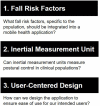The Developments and Iterations of a Mobile Technology-Based Fall Risk Health Application
- PMID: 35574255
- PMCID: PMC9091349
- DOI: 10.3389/fdgth.2022.828686
The Developments and Iterations of a Mobile Technology-Based Fall Risk Health Application
Abstract
Falls are a prevalent and serious health concern across clinical populations. A critical step in falls prevention is identifying modifiable risk factors, but due to time constraints and equipment costs, fall risk screening is rarely performed. Mobile technology offers an innovative approach to provide personalized fall risk screening for clinical populations. To inform future development, this manuscript discusses the development and testing of mobile health fall risk applications for three unique clinical populations [older adults, individuals with Multiple Sclerosis (MS), and wheeled-device users]. We focus on key lessons learned and future directions to improve the field of fall risk mHealth. During the development phase, we first identified fall risk factors specific to each population that are measurable with mobile technology. Second, we determined whether inertial measurement units within smartphones can measure postural control within the target population. Last, we developed the interface of each app with a user-centered design approach with usability testing through iterative semi-structured interviews. We then tested our apps in real-world settings. Our cumulative work demonstrates that mobile technology can be leveraged to provide personalized fall risk screening for different clinical populations. Fall risk apps should be designed and tailored for the targeted group to enhance usefulness and feasibility. In addition, fall risk factors measured with mobile technology should include those that are specific to the population, are measurable with mobile technology, and can accurately measure fall risk. Future work should improve fall risk algorithms and implement mobile technology into fall prevention programs.
Keywords: fall prevention; mHealth; multiple sclerosis; non-ambulatory; older adults; smartphone.
Copyright © 2022 Hsieh, Frechette, Fanning, Chen, Griffin and Sosnoff.
Conflict of interest statement
JS has ownership in Sosnoff Technologies, LLC received speaking fees from BrainWeek and consulting fees from Xavor, Inc. The remaining authors declare that the research was conducted in the absence of any commercial or financial relationships that could be construed as a potential conflict of interest.
Figures


References
-
- Parkkari J, Kannus P, Palvanen M, Natri A, Vainio J, Aho H, et al. . Majority of hip fractures occur as a result of a fall and impact on the greater trochanter of the femur: a prospective controlled hip fracture study with 206 consecutive patients. Calcified Tissue Int. (1999) 65:183–7. 10.1007/s002239900679 - DOI - PubMed
Publication types
Grants and funding
LinkOut - more resources
Full Text Sources

